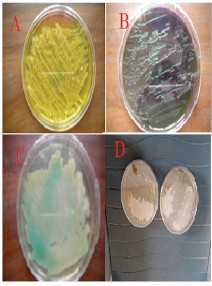Comparative prevalence of microbial infestation of artificial fingernails and natural fingernails from consented volunteers in Ibadan metropolis in South west Nigeria.
Keywords:
fingernails, Microbial infestation, microbial infestationAbstract
Background: The ability of many bacteria and fungi associated with artificial fingernails and natural fingernails to produce toxin(s) as well as exhibit other pathogenic potential is of public health concern. Superimposition of artificial fingernails over the natural fingernails has become a vogue in the fashion world particularly amongst women with little or no regards to a probable health implication. This study was carried out to compare the prevalence of microflora on artificial fingernails and natural fingernails from consented volunteers.
Methods: A cross–sectional survey of selected volunteers was randomly sampled and examined. Questionnaires were served to the respondents to sample their knowledge, attitude and practices on their choice nails. Aseptically scraped powdery crust from fingernail plate and associated fingernail underneath crust were obtained from 40 volunteers wearing artificial nails and 40 volunteers wearing natural nails. The samples were plated on diferent culture media for possible isolation of bacteria and fungi.
Results: Individual samples harbored different bacteria and fungi in varying densities with the percentages of the bacteria flora and fungi higher in those wearing artificial fingernails. The percentages of isolates obtained from artificial fingernails compared with natural fingernails were in ratios of; coagulase negative staphylococci (100:87.5), Staphylococcus aureus (95:80), Pseudomonas species(60:37.5) while Trichophyton rubrum, Trichophyton mentagrophyte were in ratio of 12.5:2.5 and 7.5: 5 percent respectively. Candida albicans was recorded to be of highest percent (15) amongst the isolates of fungi from artificial fingernails.
Conclusion: Therefore, artificial fingernails could contribute to transmission of pathogens when kept unattended to, hence an increased awareness in proper hand washing and sanitizing must be exercised when such nail enhancement i.e. artificial nails are worn to forestall this pathogen transmission.
References
Nickey HJ. (2005). 10 years younger - Channel 4 makeover series p.105-107 published 2005 by Channel 4 Books, a division of Transworld publisher ISBN 1-905-02603-X, Germany.
McGinley KJ, Larson EL and Leyden JJ.(1988). Composition and density of microflora in the subungual space of the hand. Journal of clinical microbiology, 26(5), 950 – 953. https://doi.org/10.1128/JCM.26.5.950-953.1988
Hedderwick SA, McNeil SA, Lyons MJ, and Kauffman CA.(2000). Pathogenic organisms associated with artificial fingernails worn by healthcare workers. Infection control and hospital epidemiology, 21 (8), 505 – 509.
https://doi.org/10.1086/501794
Moolenaar RL, Crutcher JM., San Joaquin VH, Sewell, LV., Hutwagner, LC, Carson, LA, Robison DA., Smithee LM. and Jarvis WR. (2000). A prolonged outbreak of Pseudomonas aeruginosa in a neonatal intensive care unit: did staff fingernails play a role in disease transmission?. Infection control and hospital epidemiology, 21(2), 80–85. https://doi.org/10.1086/501739
Pottinger J., Burns S, and Manske C. (1989). Bacterial carriage by artificial versus natural nails. American journal of infection control, 17(6): 340 – 344. https://doi.org/10.1016/0196-6553(89)90003-5
Bae Y, Lee GM, Sim JH, Lee S., Lee SY, Park YL (2014). Green nail syndrome treated with application of tobramycin eye drop. Ann Dermatol. 26(4):514–516.
Brook I. (1993) Paronychia A mixed infection. Microbiology and management. J Hand Surg Br. 18(3):358–359
Baran R. (2002) Nail beauty therapy: an attractive enhancement or a potential hazard? J Cosmetic Dermatol. 1(1):24–29.
Shelly A. McNeil, Catherine L. Foster, Sara A. Hedderwick and Carol AK (2001). Effect of Hand Cleansing with Antimicrobial Soap or Alcohol-Based Gel on microbial Colonization of Artificial Fingernails Worn by Health Care Workers Clinical Infectious Diseases. (32) :3 https://doi.org/10:1086/318488
Rich P. (2005) Nail cosmetics: the benefits and pitfalls. In: RK Scher, CR Daniel, A Tosti, B Elewski, P Fleckman, and P Rich, eds Nails: diagnosis, therapy, and surgery. China: Elsevier Saunders pp 221– 227
Atwater AR., Reeder M (2019). Trends in nail services may cause dermatitis: not your mother's nail polish. Cutis. 103(6):315–317.
Centers for Disease Control and Prevention. Nail technicians' health and workplace exposure control [Internet]. 2018
[cited 2019 July 1]. Available from: https://www.cdc.gov/niosh/topics/manicure/default.html.
Baran R, Schoon D (2004). Nail beauty. J Cosmetic Dermatol 3 (3): 167– 170.
Bryson PH, Sirdesai SJ (2010). Chapter 27: colored nail cosmetics and hardeners. In: ZD Draelos, ed. Cosmetic dermatology products and procedures, 1st ed. Hoboken, NJ: Wiley-Blackwell, p. 206– 213.
Schoon D (2010). Chapter 28: cosmetic prostheses as artificial nail enhancements. In: ZD Draelos, ed. Cosmetic dermatology products and procedures, 1st ed. Hoboken, NJ: Wiley-Blackwell, p. 215– 221.

Views | PDF Downloads:
842
/ 444
/ 0
Published
How to Cite
Issue
Section
License

This work is licensed under a Creative Commons Attribution-NonCommercial 4.0 International License.


